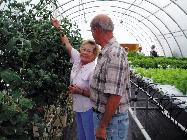Hydroponics is the art and science of growing plants in nutrients in a medium other than dirt. The yields would make a dirt farmer envious.
The taste is SO good that there's an amazing difference between "hydro" vegetables and store-bought, even between "hydro" vegetables and those from a well-tended kitchen garden. The tomatoes were amazing--so sweet, so ... well, perfect.
And there are also a lot of them. B.J. Feeney, the owner and operator of Desert Bounty, said he will be able to produce 1,200 pounds of tomatoes in the new greenhouse he has planned.
He sells his produce at the Tularosa Farmers Market 8-11 a.m. every Saturday through the end of October. It's located at the Tularosa Community Center Park on U.S. Highway 70 near Lowe's Market. "I sell lots of herbs and tomatoes, and I'm creating a market for watercress," he said.
Feeney was host to 17 members of the Otero County Master Gardener Association, showing them his greenhouses and bumblebees. The field trip was put together by President Connie Klofonda. "I went
to a festival in Tularosa and bumped into him, and he was demonstrating hydroponics," she said. "The minute I saw it, I wanted to know how far away he was so we could visit."The Master Gardeners were impressed with Desert Bounty's operation. "I've never seen anything like it before, except on TV," said Hiram Muse of La Luz. "The age of his tomato plants is the most impressive, amazing up to four years. Everybody else gets one season." His tomato vines grow to be 30 feet long, a veritable jungle of green.
Feeney's bumblebees are flying around the greenhouse, which is a little disconcerting--but they pay no attention to the visitors.
The fruit of the hydroponic process--actually vegetables--is available year-round because it is not tied to the seasons.
Feeney did his research before setting up shop. He studied what was being done in the field of hydroponics. "New Zealand and Australia are the world leaders in hydroponics technology, and Europe, especially Holland, uses it because of the limited availability of land," he said.
"Hydroponics took off in the 1980s,"Feeney said, putting nutrients in a water-soluble form.
The specialty field even has its own magazine, "The Growing Edge," Feeney said. "It's the only one dedicated to hydroponics; it comes out every other month. There's also an Australian publication, ŒMaximum Yield.'"
Feeney decided to start his hydroponics operation in New Mexico, because of the number of days of sunlight the state has. "New Mexico is one of few states in the union that has at least 180 hours of sunlight a month, the minimum needed to grow tomatoes. The worst is 214 total in December and January."
He gets bumblebees and beneficial insects by mail order; a gardener can't pick them up at Wal-Mart. He has two hives hung in the greenhouses, each with 60 workers and a queen. "They are very impressive workers; they know exactly when to pollinate the flowers," Feeney said. "One bumblebee can fly 12 miles and pollinate 10,000 flowers a day. They are the best pollinators."
They are also "very smart. When the door is open, all the bees go home to the hive. They are the best workers you can hire for the money."
He also buys beneficial insects, like ladybugs and other predators, which eat aphids and white fly larvae.
Desert Bounty is located near Tularosa, and Feeney sells his produce every Saturday morning at the Tularosa Farmers Market. Because it is so lush and healthy looking, he sells out fast. "I grow a lot of different varieties of lettuce, for example," he said. "My Œmesclun' mix has seven different lettuces in it. It's grow-your-own salad."
One of the tomatoes he grows is Trust, which he says was the first beefsteak tomato, introduced in Philadelphia in 1850. "It's been the standard ever since," Feeney said. Some of those facts he looks up in the World Book of Vegetables he has from the University of Arkansas.
Feeney didn't just stumble into hydroponics; he made a conscious choice. He had a greenhouse in Virginia. His son Bill, who has a degree in horticulture from Florida State University, built it by putting plastic over a carport.
Feeney served 30 years in the U.S. Air Force and another 10 with the U.S. government as a contractor. "I used to come out here (to the Tularosa area) on business trips for the Air Force," he said. "I liked the area, so I bought some land." He has five acres now. "I moved here from Virginia a year ago," he said.
He has two 26- by 60-foot greenhouses he took a week each to build, digging the holes, putting in cement for anchors then adding galvanized steel hoops and plastic.
These are much more sophisticated than his operation in Virginia.
For example, watering and feeding nutrients is computer regulated in his two big greenhouses. "Everything I grow is in water," he said.
Feeney went to hydroponics school in Ohio, making the 12-hour drive from Virginia for classes. He also went to Crop King in Ohio and studied the operation at the University of Arizona, the leader in the field. He learned the mechanics of the operation well.
"Everything is computer run," he said. "It mixes nutrients at the right proportion. The water goes to the mixing tank. Nutrient ŒA' has the basic N-P-K--nitrogen, phosphorous, potassium. Tank ŒB' has trace minerals, including calcium." Each plant has taken in 40 ounces of nutrients, two quarts a day for 140 plants.
The water he uses is RO, reverse osmosis, he said. Desert Bounty has a separate building for the RO operation. "The computer samples the mix every two minutes and adjusts if it's too high or low."
He uses 750 gallons of water a day from his 226-foot well, mostly on the tomatoes. The water is recirculated where possible. Reverse osmosis is necessary, he said, "because the water is so heavily packed with all kinds of nasty things, with minerals, iron and other stuff, that it cooks the roots and prevents them from taking up nutrients. The tomato plants get 6 or 7 inches tall and quit growing."
Oasis cubes-foam and perlite are used to hold the water in some pots. The water is piped through a series of tubing. He uses 3/8-inch diameter perlite for the tomatoes.
He doesn't grow root crops; they are so cheap to buy, it's a waste of space. "I couldn't sell them for what it would cost me to grow them."
Hydroponic farming, he said, uses one-sixth of the land and one-tenth of the water of conventional farming. "Water is such a valuable resource, you don't want to waste it."
The greenhouses are made of 6-millimeter soft plastic, UV-treated. "The end walls are polycarbonate, military color and will last for 10 years," Feeney said. Shade cloth blocks 40 percent of the light in some places.
He starts plants in gutters, with 72 holes, and then transplants them. This method gives him 13 crops a year.
Hydroponics is effective and efficient, but not perfect. Feeney struggled this year to combat blossom end rot, which afflicts tomatoes. "I thought it was a calcium deficiency. I had to throw away 700 tomatoes, about 320 pounds."
And one week he sold 45 pounds of split tomatoes for $1.50 a pound. Consider the economics. One of the varieties of tomato he grows and markets is "the hybrid Blitz. Its seeds cost 58 cents apiece."
The tomatoes are like a jungle, with long vines up to 30 feet, heavy with their fruit. "After they are 30 feet long, they get too long and production falls off."
In another area are small "jingle bell" red peppers, the size of a half-dollar and very sweet.
He grows a lot of different varieties of lettuce and is expanding that product, planning on marketing lettuce to local grocery outlets. He grows seedless, burp-less cucumbers that are 14 inches long and don't have to be peeled.
Feeney sells his tomatoes for $2 a pound. It's a matter of perspective, he said. "People say that is high, but they pay $5 a pound for pistachios and $4 a pound for cherries, so $2 a pound for tomatoes looks good. You go into Wal-Mart or Lowe's and pay $2.80 for 8 ounces of grape tomatoes, that's $5.60 a pound."
Feeney said he is considering using solar energy in the greenhouses in the future, "with solar panels in each greenhouse," he said. "I just put natural gas lines in this week for heaters."
He said he has a contract with Lowe's to provide produce all winter.
Feeney has a 95-foot greenhouse under construction now where he will put 630 tomato plants, which will produce "about a thousand pounds a week."
Hopefully, he said, the operation with his investment of more than $20,000 "will pay for itself in two years."
Feeney gave the Master Gardeners a tip on what he considers the best way to preserve the flavor in fresh herbs: mince them and freeze them in ice cube trays. When frozen, put the herbed ice cubes in plastic bags in the freezer. Then the cook can just pop the desired amount into a soup or stew or whatever is being cooked.
There may be others out there, but Feeney said, "I've never seen anybody else do this in New Mexico."
His motivation is simple: "I don't think anything tastes better than homegrown hydroponic vegetables," he said.
Bev Eckman-Onyskow is an Alamogordo-based freelance writer and vice-president of the Otero County Master Gardener Association.









